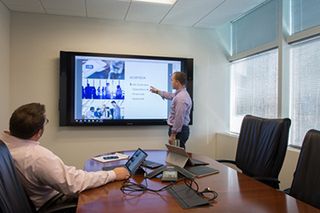
An image from the USI Insurance Agency headquarters in Valhalla, NY. It uses the Atlona CLSO-612 presentation switcher to support content in their conference rooms.
By 2020, half of the smart city objectives out there will include climate change, resilience, and sustainability as key drivers. So predicts the research and analysis firm Gartner Inc., headquartered in Stamford, Conn., while also noting that smart buildings are already playing a key role in larger, city-wide efforts. In 2017, 58 percent of all IoT devices involved use cases in smart commercial buildings and transportation facilities contributed to the whole “smart” movement.
So what is AV’s role going to be in all this? Michael Crisci, business development manager for AVoIP and strategic alliances at Atlona Inc., a networked AV solutions developer headquartered in San Jose, Calif., argues that AV technology already contributes to making buildings smarter. Take sensor technology: not only can it serve to alert HVAC, blinds, and lighting systems when a building is occupied, it can also notify the systems in a specific meeting room when it’s time to fire up the collaboration gear. “That’s all part of the building technology, but it’s also AV technology,” he said.
AV is Integral to the Smart Building of Tomorrow

Michael Crisci, Atlona
It can go further, however. Michael Carter, senior consultant of smart building solutions for the JLL Smart Building Program at global real estate firm JLL, headquartered in Chicago, Ill., believes that gaining a grasp on the role AV plays in smart buildings requires an understanding of what smart buildings actually are. “People speak of the Internet of Things as devices and sensors and various components that can be connected to collect data, to activate functions, to take things that haven’t traditionally been connected and connect them,” he said. “But a smart building has to take it to the next level. A smart building is more about the integration of those systems.” Along these lines, building systems and business systems work together. “And that’s where AV comes into play. AV is a core strategy of workplace systems.”
In other words, AV isn’t just about delivering images to a display. “AV is about communications and collaboration,” Carter said. “It’s important to think about AV as a core communications tool within the framework of an enterprise.” AV control systems manufacturers began with putting AV on the network, and then evolved to offer features like scheduling capabilities and resource management. “The management platforms make [the systems] work in concert with the people, and the schedule, and the needs—the day-to-day needs—of the users. That’s really the smart building/smart workplace strategy, and that is where I think AV’s value comes in.”
Where to Begin?

Reto Brader, Barix
For those tech managers who aim to make their facilities smarter, often the challenge is figuring out where to start. Pretty much everything these days can be connected to a network, but whether or not an “everything connected” environment is right for a specific organization’s needs is another matter. Crisci suggests that before researching the most glamorous building projects out there to serve as models, tech managers should conduct a thorough discovery process to determine what best suits their organization’s culture. “They really need to understand their environments, first off,” he said. From there, he suggests looking into the information supplied by building management platform developers such as Siemens, or Johnson Controls, and what’s offered in the way of control technologies. “Understanding how that aligns with their individual culture is really the best place for them to start … because if you know you’re not going to become the most connected building in the world and you just want to make sure that you’re being a little conservative on energy, you might not have to go so deep down the rabbit hole.”
“I think [you take] a classic business approach: you find out where the pain is and then that’s what you want to connect,” said Reto Brader, vice president of sales and business development at Barix AG, an IP-based device and control technology manufacturer headquartered in Zurich, Switzerland. He cites one Barix client that is currently rolling out a project across a number of cities and towns across France: using Power over Ethernet (PoE) technology, city halls are able to control streetlights from a centralized location. The streetlights are fitted with loudspeakers that utilize Barix audio IoT devices to drive them. “If there is a town market and somebody wants to talk, or if there is a market and they want to play some music, they can use the internet to put that out. You no longer have to bring a whole PA system [to make an announcement]; you just bring a microphone, you plug it into our device, and it uses IP to stream it to the loudspeakers.”
Getting Smarter About Security
Of course, the tricky aspect of all things connected is security, and the delicate balancing act that’s involved in managing risk. “The technology itself has to align with the stringent security requirements that exist within an enterprise environment, otherwise you’re not going to see it matriculate through that environment,” Crisci said. While there’s an argument for evolving guidelines to allow certain—safe—technologies to be deployed, AV tech developers need to put security at the forefront. “As we’ve all seen from some of the fraud [events] that have been going on, most of that came from the weakest point. I think AV and smart technology is that next weak link, and as it makes itself to the core network more, we’re all going to have to step up our game.”
Carter argues that securing AV devices isn’t enough; securing access and management of the devices is what enterprises require. “To be fair, some [AV manufacturers] are doing that, [but] I don’t think enough are,” he said. “People have been talking for years about the convergence of AV and IT. And really, it’s not a convergence. It’s: AV is just another service on the network, or should be looked at from that perspective.” This means that AV technology manufacturers need to follow the enterprise security and access control management guidelines that are standard in the IT world. “It’s got to work within their framework; it’s got to fit within their IT management platform to be able to manage access and passwords and whatnot.” And, he emphasizes, it’s got to have a standard patch model.
Learning from Smart Cities
The relationship between smart buildings and smart cities promises to reap significant rewards, and in many cases, the technology exists for the two to work hand-in-hand. “I think it falls into this big data category; once you have the information that’s out there and trackable, then people can start really looking at it and coming up with a better game plan,” Crisci said. But, he adds, the sheer amount of data that we’re able to produce these days makes it difficult, right now at least, to apply this information in a meaningful way.
There’s also the issue of infrastructure: as Crisci points out, cities are often reliant on technology that is decades—if not over half a century—old. The challenge then becomes determining the most efficient, economical way to conduct upgrades, and oftentimes this turns into a roll of the dice: for example, should a city incur the expense to implement a clean power solution today? Or would it be better to wait five or 10 years when the technology is more mature, cheaper, and easier to deploy? But will that technology actually be cheaper and easier to deploy … and does it make sense to continue to incur the costs associated with maintaining an outdated infrastructure until then? These are the types of decisions that win—or lose—elections.
But for Carter, the possibilities outweigh the challenges. Why shouldn’t a remote employee be able to access data—such as traffic reports, train schedules, parking availability, the location of charging stations for electric cars—through a company-specific mobile app when they’re due to report to headquarters? Why shouldn’t they be able to access this information through an app designed exclusively for their organization, in the effort of being truly smart? “More and more companies are looking at a mobile app experience because that’s what’s happening outside,” he said. “That’s where this bridge to the outside comes in; everybody uses mobile apps every day … how does AV connect to that? Again, AV is just one of the services that are on that global network.”
Carolyn Heinze is a freelance writer/editor.
INFO









